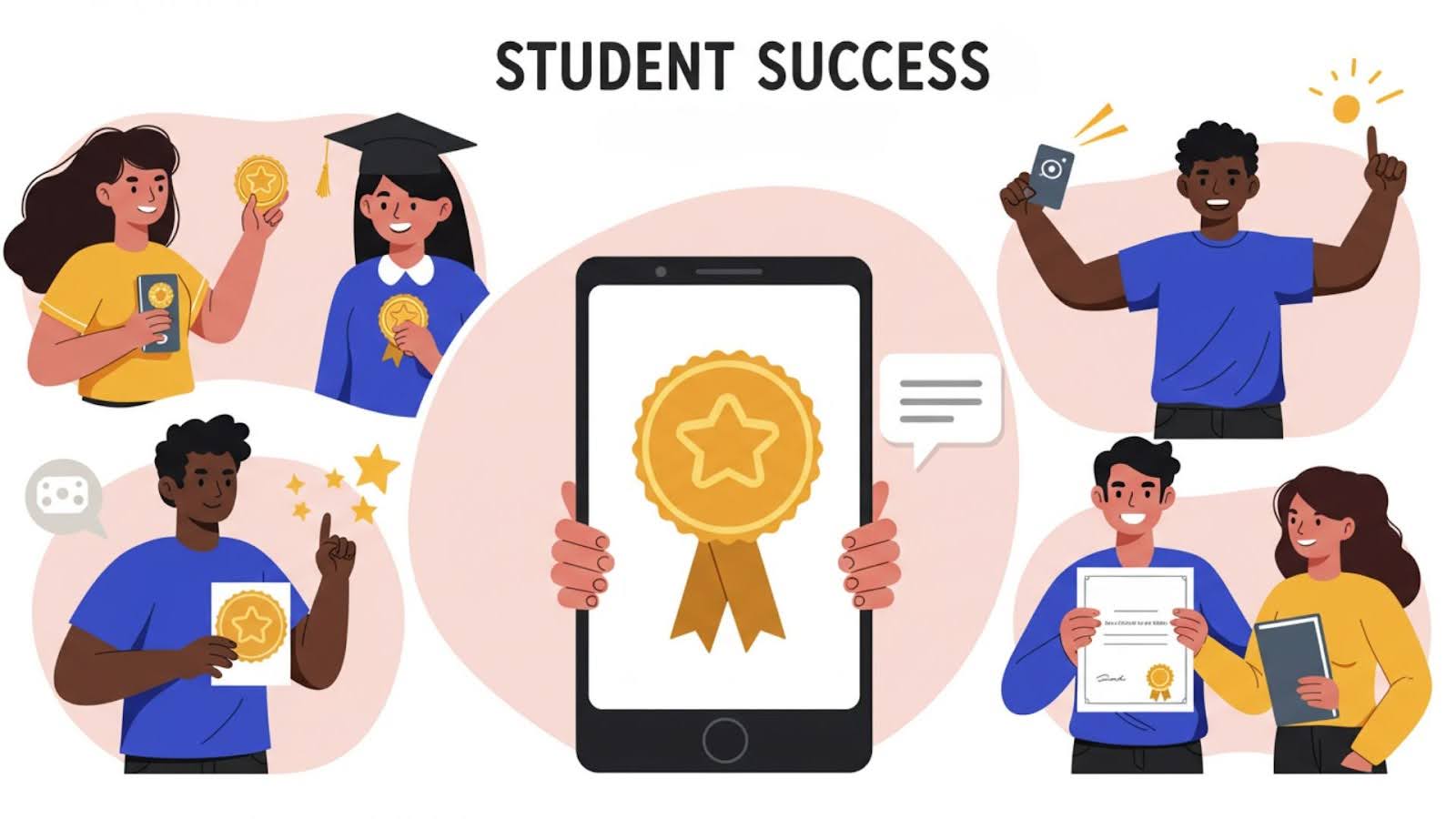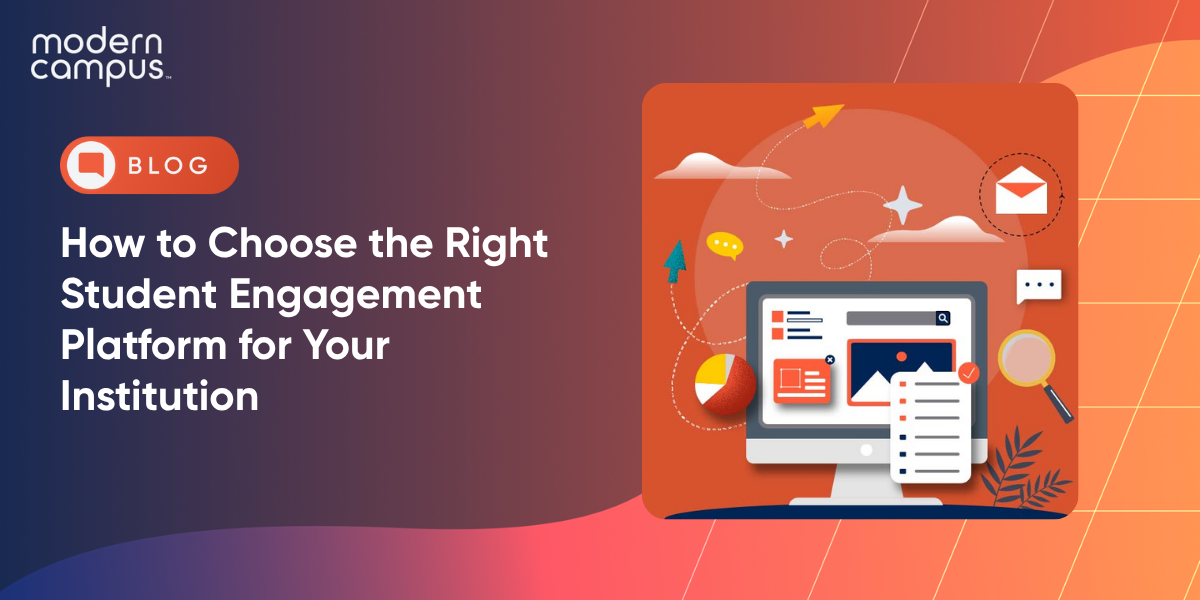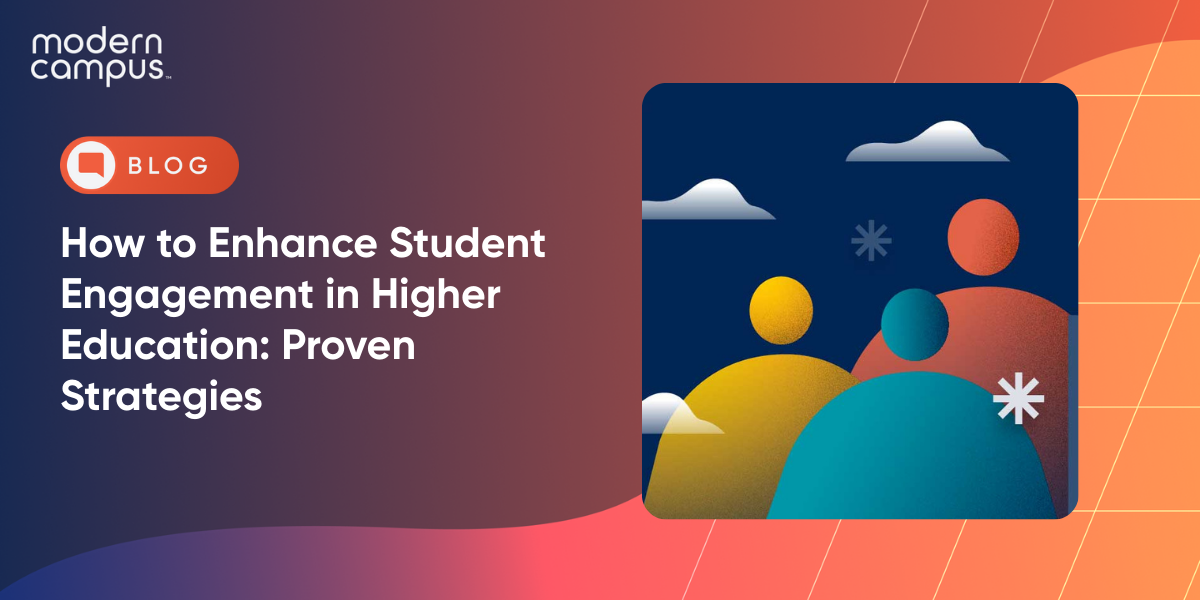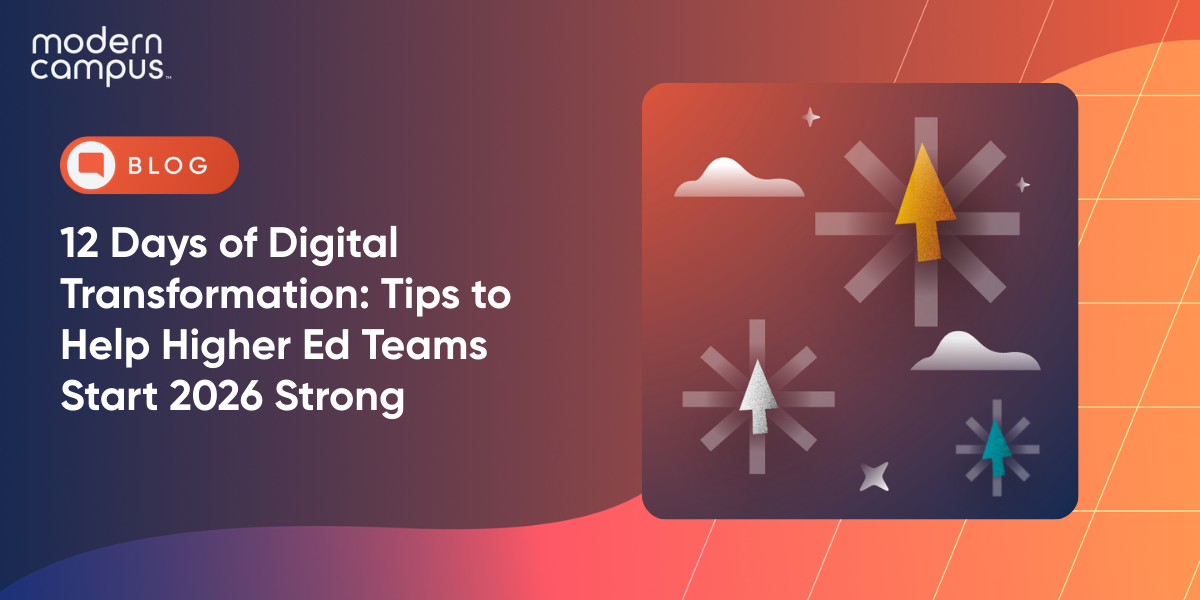How to Choose the Right Student Engagement Platform for Your Institution
As institutions face fluctuating enrollment, shifting student demographics and rising expectations for digital-first experiences, student engagement is a priority. Whether traditional undergraduates, adult learners or workforce upskillers, learners expect their institution to deliver support, communication and opportunities that are personalized, intuitive and available on their terms. Most prospective students expect higher education websites to tailor content to their interests and needs. This demand for personalization and real-time responsiveness isn’t limited to marketing. It extends into every stage of the student lifecycle, from recruitment to retention and beyond.
In response, more institutions are turning to student engagement platforms to meet these expectations and cultivate meaningful relationships with learners. But with a crowded marketplace of solutions and increasing pressure to justify technology investments, it’s not always clear which platform is the right fit. The term "student engagement platform" itself encompasses a range of software capabilities: event participation tracking, personalized communications, co-curricular learning tools, mobile access and robust analytics.
Some platforms focus on communication alone, while others integrate with broader institutional systems to support outcomes like retention, career readiness and lifelong learning. This blog will help you navigate the key features to prioritize, align technology with your institutional goals and learn from real-world success stories to ensure you invest in a solution that drives lasting impact.
What Is a Student Engagement Platform?
A student engagement platform is a digital system designed to help institutions foster meaningful interactions with students throughout their educational journey. More than just a communication tool, a robust engagement platform serves as a central hub for promoting co-curricular activities, measuring participation, streamlining personalized outreach and tracking behavioral indicators that influence student success. It enables institutions to meet students where they are, whether that’s on mobile devices, through text and email or via web portals, and deliver experiences tailored to their goals, interests and needs.
What makes these platforms especially powerful is their ability to unify fragmented touchpoints into a cohesive, data-informed strategy. Rather than relying on separate systems for event management, advising, retention initiatives and marketing outreach, student engagement software brings these functions together in one place. The result is operational efficiency for staff and a more consistent and satisfying experience for students.
For example, a student might receive a personalized notification about an upcoming leadership workshop aligned with their major, automatically log their participation toward co-curricular credits and receive follow-up guidance on related internships, all within the same system. In this way, engagement software doesn’t just encourage involvement; it connects those moments to broader outcomes like skill development, persistence and post-graduation readiness.
For institutions navigating enrollment and accountability, these platforms are essential. Student engagement is a measurable, strategic imperative, and the right platform can be the difference between a disconnected learner and a lifelong advocate for your institution.
![]()
Key Features to Look For in Student Engagement Software
While most engagement platforms offer some combination of messaging and event tracking, the most effective ones bridge the gap between institutional goals and student expectations. To evaluate a platform’s true value, look beyond surface-level functionality and assess how well the software supports personalization, integration, analytics and accessibility. Each of the following features is valuable in driving sustained engagement.
Personalized Communication Across Channels
Students are inundated with messages from all directions, so generic outreach tends to be ignored. However, 77% of surveyed students prefer to receive texts from their colleges and universities. Effective student engagement software provides the infrastructure to deliver hyper-personalized communication at scale across SMS, email, push notifications and web portals.
Leading platforms allow institutions to segment audiences based on program type, academic progress, interests and behavioral data. For instance, a first-generation student with a STEM major might receive reminders about peer tutoring sessions and mental health resources, while a returning adult learner might get nudges about flexible registration hours or career development workshops.
Even more valuable is when platforms blend automated responses with opportunities for human touchpoints. This kind of blended communication model ensures that students feel seen and supported without overwhelming staff. Done right, it reduces missed opportunities, accelerates time-to-action and increases the odds that students stay engaged with their educational path.
Seamless Integration With Your Existing Tech Stack
A powerful engagement platform should eliminate siloes. One of the biggest red flags when evaluating software is a lack of integration with your institution’s existing tools. Whether it's your Student Information System (SIS), Learning Management System (LMS), CRM or curriculum catalog, the platform should pull from and feed into these systems to ensure data accuracy and real-time synchronization.
Seamless integration benefits IT teams and enables smarter decision-making across departments. For example, if a platform can integrate co-curricular data with advising records, staff can identify students who are highly engaged outside the classroom but struggling academically, prompting timely outreach. Similarly, if it connects to scheduling tools, students can be guided to events or workshops that don’t conflict with their class hours. The result is a unified ecosystem where engagement insights inform institutional action and student experiences alike.
Data-Driven Engagement Tracking
Institutions can’t improve what they don’t measure. Real-time analytics and engagement tracking are non-negotiable components of effective software. The best platforms surface actionable insights into how, when and why students are engaging (or not). Administrators can monitor event participation, message open rates and system interactions to uncover trends or gaps in outreach strategies.
These insights can be used proactively. For instance, a drop in event attendance from a particular student demographic might signal disengagement or evolving needs. With that information, institutions can tailor programming or interventions before the issue impacts retention. Some platforms also use predictive analytics to identify at-risk students based on engagement patterns, allowing for targeted support that’s grounded in data, not guesswork.

Mobile-Friendly and Accessible Design
Students are mobile-first. They expect to interact with their institution as easily as they do with their favorite apps, whether they’re signing up for a career fair, asking a question or checking their progress toward graduation. Student engagement platforms must be fully mobile-optimized, offering intuitive navigation and functionality on smartphones and tablets without sacrificing the user experience.
Equally important is accessibility. An inclusive platform ensures that all students, regardless of ability, can navigate digital spaces independently. Compliance with WCAG guidelines, compatibility with screen readers and thoughtful UI/UX design are central to fostering equitable access to resources and opportunities. Institutions that prioritize accessibility signal a commitment to serving the diverse needs of their student body while mitigating legal and reputational risks in the process.
Aligning Platform Capabilities With Institutional Goals
Choosing the right student engagement software ensures that the platform supports your institution's broader mission and strategic objectives. Whether your priority is boosting retention, cultivating co-curricular development or serving diverse learner populations, the right platform should act as a force multiplier, amplifying your efforts and adapting to your evolving goals.
Boosting Retention Through Proactive Support
Retention is one of the most pressing challenges in higher education, with nearly one in four students dropping out before their second year. Many of these departures are preventable. Students don't drop out because they lack ability but because they feel disconnected, overwhelmed or unsupported. A strong student engagement platform can help reverse this trend by enabling proactive, data-informed interventions.
Instead of waiting until a student misses classes or fails a course, institutions can use engagement signals, like low event participation, unread messages or declined invitations, as early warning signs. When paired with automated nudges and human outreach, staff can offer timely assistance and reengagement strategies. For example, students who don’t attend orientation sessions can be auto-enrolled in a virtual onboarding module or invited to meet one-on-one with an advisor. These targeted efforts keep students on track and demonstrate that someone is paying attention.
Enabling Co-Curricular Involvement and Skill Building
While academic success is essential, employers and students alike increasingly value experiences that take place outside the classroom. Leadership roles, volunteer opportunities, club participation and skill-building workshops all contribute to a student’s overall development and employability. A robust engagement platform should help institutions track, validate and promote co-curricular learning in a way that adds real value to the student journey.
For example, platforms with built-in digital badging or experience tracking can help students visualize their growth across soft skills like communication, collaboration and problem-solving. Students reinforce their learning and receive tangible artifacts they can showcase to future employers.
At an institutional level, having insight into which programs foster the most engagement helps shape resource allocation and strategic programming. It’s about building a framework for holistic student success.
Supporting Non-Traditional and Continuing Learners
Today’s student body is increasingly diverse not only in background but in life stage, goals and educational pathways. More adults considering enrollment now prefer non-degree or alternative programs, and many are juggling full-time jobs, caregiving responsibilities or geographic constraints. The right student engagement software should be built with flexibility and inclusivity in mind, accommodating the unique rhythms of continuing education and workforce learners.
A good strategy involves offering asynchronous communication, personalized learning pathways and access to digital resources that don’t require a traditional campus presence. Platforms that allow institutions to tailor messaging and programming based on learner personas, such as career switchers, certificate seekers or degree completers, ensure that non-traditional students aren’t treated as an afterthought. Instead, they become an integral part of the engagement ecosystem, empowered to succeed on their terms.
Use Cases: Real Institutions, Real Results
Nothing illustrates the value of student engagement software more than seeing its impact in action. Institutions that have adopted purpose-built engagement platforms are enhancing the student experience while meeting strategic goals around retention, digital experience and leadership development. Below are two examples of how colleges have successfully implemented these tools to solve real challenges and create measurable outcomes.
Improving Leadership and Belonging: A Community College’s Success Story
One large community college recognized a growing disconnect between students and campus life, particularly among underserved populations. Despite offering a robust slate of student organizations and events, participation rates were flat, and leadership development programs were underutilized. After implementing a digital engagement solution that tracked student involvement and encouraged co-curricular participation through mobile-friendly tools and skill-building pathways, the institution saw a dramatic shift.
Students who engaged with the platform were significantly more likely to return year over year, a clear signal that connection and community were influencing persistence. The platform’s gamified experience and digital badging helped students visualize their progress, boosting confidence and reinforcing soft skill development, traits that also improved career readiness. Staff could track engagement trends, identify students at risk of isolation and intervene with timely outreach, transforming engagement from a passive option into a proactive retention tool.
Streamlining Digital Experiences for Better Conversion
A private health-focused college faced a different challenge: its online presence was unintentionally creating friction for prospective students. With siloed content, unclear navigation and a lack of personalization, the digital experience failed to reflect the institution’s learner-first values. The turning point came when the college adopted a web content and engagement solution that made their online interface both dynamic and intuitive.
By integrating student engagement tools directly into the website experience, the college empowered visitors to quickly find the information they needed, explore relevant programs and take next steps without staff intervention. Personalized content delivery based on user behavior led to a marked increase in inquiry conversions.
Behind the scenes, staff benefited from streamlined workflows and data-driven insights into what resonated most with students. The result was a digital environment that mirrored the institution’s commitment to student success and converted curiosity into action.

These examples underscore how the right engagement platform is a strategic asset. Whether the goal is to build community, drive enrollment, or personalize outreach, successful institutions are finding that digital engagement solutions provide the infrastructure and intelligence to meet those goals with precision.
Questions to Ask Before You Choose a Student Engagement Platform
With so many student engagement platforms on the market promising personalization, analytics and improved outcomes, it can be easy to get swept up in flashy demos or surface-level features. But a platform that looks sleek isn’t always the one that will deliver lasting results. To make a smart, strategic decision, institutions should dig deeper and ask questions that reflect not just current needs but future goals, staffing realities and learner expectations. These questions can reveal whether a platform is truly built to support your students, your staff and your mission.
Does It Support the Full Learner Lifecycle?
Many platforms claim to “engage students,” but that can mean anything from sending text reminders to tracking event attendance. Institutions should ask whether the software supports meaningful engagement across the entire learner journey, from prospective student to alumni. Can it deliver personalized content to students exploring programs online? Does it help new enrollees navigate orientation and onboarding? Can it measure skill development and track involvement over time? A platform that supports only one phase of the journey may end up creating more fragmentation, not less.
It’s also worth asking whether the system can grow with the student. For instance, can it recognize a student who started with a certificate program and is now pursuing a degree? Can it surface relevant career services or co-curricular pathways as students progress? The most valuable platforms adapt alongside learners, not those that require institutions to bolt on new tools at every stage.
Can It Scale With Your Enrollment Goals?
Whether your institution serves 1,000 students or 50,000, scalability is essential. A student engagement platform should offer the flexibility to grow with your enrollment strategy, whether that includes expanding to new campuses, adding online programs or targeting adult learners. Be sure to ask whether the software can handle varying levels of engagement, such as automated for general outreach and high-touch for at-risk populations, without requiring excessive manual effort from staff.
Institutions with ambitious enrollment goals should also evaluate how the platform supports recruitment. Does it provide insights into what prospective students are engaging with on your website or outreach campaigns? Can it personalize communications based on demographic, behavioral or academic interests? The right engagement platform actively fuels growth by helping staff focus efforts where they matter most.
What Kind of Support and Training Is Offered?
When evaluating engagement platforms, ask what kind of ongoing support, training and onboarding is included. Does the vendor offer guided implementation and institution-specific best practices? Will your staff have access to continuous learning resources, live support or a dedicated success manager? These elements can determine how quickly you realize value and how broadly the platform is adopted across departments.
In addition, ask whether the platform includes community forums or professional development opportunities for users. Learning from peer institutions can be just as valuable as vendor training. The more your team is empowered to use the platform creatively and confidently, the more it will drive tangible results for your institution.
Empower Meaningful Engagement for the Long Term
Selecting the right student engagement platform lays the foundation for long-term student success. As learners become more discerning and digitally driven, institutions need tools that connect students to opportunities and cultivate a sense of belonging, purpose and momentum throughout their journey. The most effective platforms become integral to retention strategies, co-curricular learning and institutional growth.
At Modern Campus, we’ve built our platform from the ground up to support the full learner-to-earner lifecycle. We understand that engagement is a continuous, evolving relationship. That’s why we focus on personalization at scale, seamless integration with your existing systems and real-time analytics that empower staff to act with precision. Our solutions are designed exclusively for higher education, drawing on decades of experience to help institutions like yours deliver modern, flexible and student-centered experiences. Request a demo to turn engagement into a strategic advantage.
Last updated: May 30, 2025



